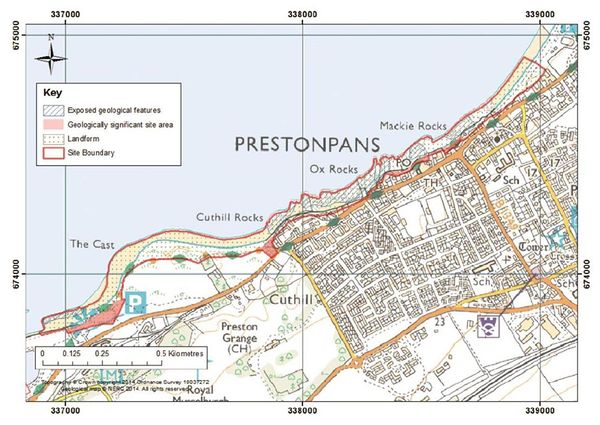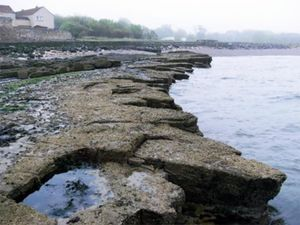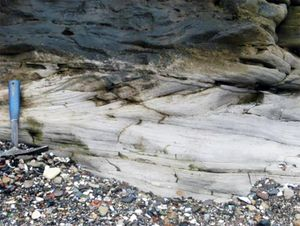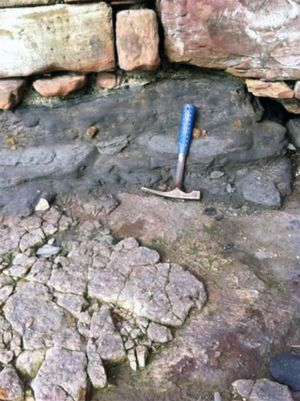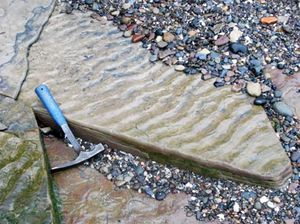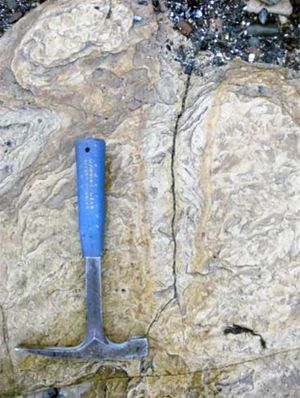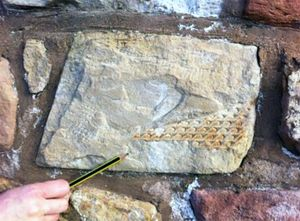OR/14/063 Site assessment - ELC 15: Prestonpans Shore, Prestonpans
| Whitbread, K, Ellen, R, Callaghan, E, Gordon, J E, and Arkley, S. 2014. East Lothian geodiversity audit. British Geological Survey Internal Report, OR/14/063. |
| ELC_15: Prestonpans Shore, Prestonpans | |
| Site Information | |
| Location and Summary Description: The site comprises a 2.6 km section of coastline at the town of Prestonpans. The site displays strata from the Upper Carboniferous, increasing in age from west to east. The important stratigraphic horizon of the Index Limestone, is seen at the site. | |
| National Grid Reference: Mid-point: 338063,674308 |
Site type:
|
| Site ownership: Crown Estates | Current use: Open shoreline |
| Field surveyors: Sarah Arkley and Eileen Callaghan | Current geological designations: None |
| Date visited: 30th April and 7th May 2014 | Other designations: Firth of Forth Ramsar, Wildlife site (Levenhall Links) |
| Site Description |
| Background Prestonpans is located approximately 9 miles east of the City of Edinburgh. It is a town with a rich industrial heritage which has made use of its geological resources. Coal has been mined in this area for over a thousand years; originally it was used to boil seawater in large metal pans to produce salt. In more recent times the coal, clay and limestone deposits were used in the manufacture of bricks, pottery and glass. Sedimentary Rocks The uppermost unit of the Upper Limestone Formation, exposed in the westernmost rock platform comprises a massive fine- to medium-grained, buff-coloured sandstone forming an intertidal shore platform (Photo ELC_15 P1). Sedimentary structures within the sandstones including ripples, cross- bedding (Photo_ELC_15 P2), and channels are indicative of deposition in fluvial environments. To the east the strata are cyclic, comprising beds of sandstone, mudstone and siltstones with ironstone beds and nodules (not greater than 5 cm). Fossilised worm casts are also present in the sandstone (Photo ELC_15 P3). The softer mudstones and siltstones are weathered leaving the sandstones more prominent. These cyclic strata were deposited at a time when sea-levels were rising and falling creating marine and deltaic environments. The Index Limestone (Photo ELC_15 P4) is an important marker bed which divides the Upper Limestone Formation from the underlying Limestone Coal Formation. At this site the Index Limestone is pale to dark grey and although covered in barnacles, it is possible to identify fossil material: crinoidal debris, shells e.g. Productus sp. and gastropods (Photo ELC_15 P5). The limestone has a distinctive weathered appearance (Photo ELC_15 P6). The Limestone Coal Formation is exposed in the eastern part of the site and comprises massive yellow sandstones with sandy mudstones to thinly bedded orange to buff coloured sandstones, grey mudstones, siltstones, sandy mudstone and ironstone nodules. The Limestone Coal Formation is typically characterised by the presence of thin coal seams, however coal outcrops are rarely seen within the site, possibly due to preferential erosion of the softer material. Organic rich mudstones and seatearths, commonly associated with coal, are seen in places on the rock platform (Photo ELC_15 P7). Sedimentary structures including ripples (Photo ELC_15 P8) and cross bedding are present in the sandstone and siltstone beds, indicating deposition occurred in a flat coastal deltaic environment. The prevalence of plant material in parts of the strata is also indicative of terrestrial settings. Igneous Rocks Structural Geology Made Ground Access and Additional Information |
| Stratigraphy and Rock Types | |
| Age: Upper Carboniferous | Formation: Upper Limestone Formation |
| Rock type: Sandstone, siltstones, mudstones, limestones and a few coals | |
| Age: Upper Carboniferous | Formation: Limestone Coal Formation |
| Rock type: Sandstones, siltstones, mudstones, coals and ironstones | |
| Age: Carboniferous | Formation: Central Scotland Late Carboniferous Tholeiitic Dyke Swarm |
| Rock type: Quartz-microgabbro | |
| Assessment of Site: Access and Safety | |
| Aspect | Description |
| Road access and parking | Good access from car parks located at Morrisons Haven to the west of the site and Preston Links to the east of the site. There is also parking within the town with access onto the shore. |
| Safety of access | Easy access to the shore but all visitors should be aware of the tide times when planning a visit, as most of the exposures are only visible at low tide. There is a walkway between the foreshore and the buildings but this can be very slippery and is also covered at high tide. |
| Safety of exposure | The rocky exposures have an uneven surface and are often slippery with seaweed. Stout footwear is recommended. The site is exposed to the open sea and the weather forecast should be checked before visits. |
| Access | Access is along the foreshore/beach and there are numerous footpaths leading down to the site from the town and car parks. |
| Current condition | The rocks can be covered in barnacles and seaweed. The exposures which are subsumed within local buildings are clean and free of vegetation. |
| Current conflicting activities | None known. |
| Restricting conditions | Tide: many of the geological exposures are located in the intertidal range and therefore covered at high tide. |
| Nature of exposure | Intertidal and beach exposures. |
| Assessment of Site: Culture, Heritage & Economic Value | |
| Aspect | Description |
| Historic, archaeological & literary associations | Morrisons Haven is the locality of an old fort (pulled down by Cromwell in 1650) and harbour. In the 18th century the harbour was a busy port used to export salt, coal bricks and ceramics from Prestonpans. It was abandoned in the early 20th century and partly filled in.
The Battle of Prestonpans, 1745 was fought just on the outskirts of Prestonpans. Historic houses within Prestonpans are Preston Tower (NTS dating from the 14th Century), Northfield House (17th Century) and Hamilton House (NTS, 17th Century). |
| Aesthetic landscape | Coastal. |
| History of Earth Sciences | John Muir Way passes through Prestonpans. |
| Economic geology | Prestongrange was an area of commerce and industry from the 13th Century. The coal mined in this area helped build the industries of glass making in 17th century, the first of its kind in Scotland. Salt panning in the 12th and 13th century, brick production and brewing (John Fowler & Co Ltd started brewing in 1720 in a former whisky distillery, brewing ceased in 1962 Coal mining ceased in 1961 and brick production ceased in 1975.
Many of the buildings along the shoreline appear to have been built using local stone (Photo ELC_15 P13). |
| Assessment of Site: GeoScientific Merit | ||||
| Rarity | Quality | Literature/Collections | Primary Interest | |
| Lithostratigraphy | Regional | Excellent | X | |
| Sedimentology | Local | Good | ||
| Igneous/Mineral/Metamorphic Geology | Local | Moderately Good | ||
| Structural Geology | Local | Good | ||
| Palaeontology | Regional | Moderately Good | ||
| Geomorphology | ||||
| Site Geoscientific Value | ||||
|
This site displays a sequence of coal bearing Upper Carboniferous strata from the Limestone Coal Formation to the Upper Limestone Formation. The Index Limestone is also exposed in a rare natural exposure of this important marker horizon within the Midland Valley of Scotland. | ||||
| Assessment of Site: Current site usage | |
| Community | The easy access to the shore and the shore walkway is used regularly by locals. The John Muir Way passes through Prestonpans which attracts visitors from further afield. |
| Education | The site displays a variety of features suitable for amateur geologists to study depositional sedimentary environments. The exposure of the Index Limestone allows for the study of this important indicator as well as the fossils found within the strata. |
| Assessment of Site: Fragility and potential use of the site | |
| Fragility | Weathering/erosion; development of coastal defences. |
| Potential use | On-site interpretation, on site geo-trail, school and higher education. |
| Geodiversity Summary | |
| This site contains a good variety of geological features especially associated with sedimentary strata. It exposes a sequence of the Upper Carboniferous along with a dyke intruding into this sequence. The sedimentary structures seen allow interpretation of the terrestrial, deltaic and marine depositional environments of the upper Carboniferous.
The coastline is attractive and has easy access. There are numerous possibilities for adding geological interpretation to this site, especially along the John Muir Way. | |
